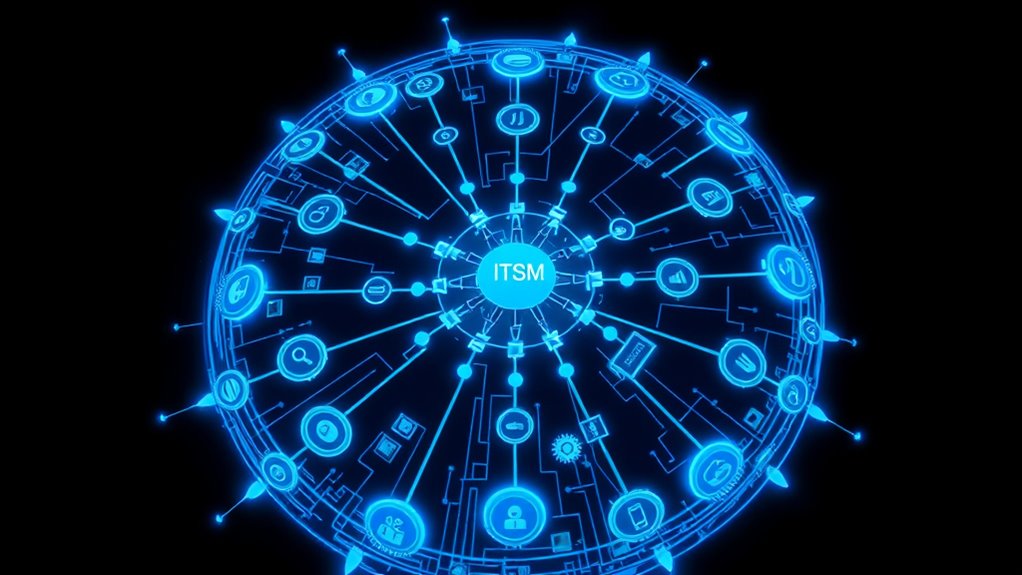A successful ITSM integration strategy requires careful alignment of business objectives with IT service delivery goals. Organizations must select appropriate frameworks like ITIL or COBIT, implement modern ITSM tools with automation capabilities, and establish clear process documentation. Essential components include knowledge management integration, AI-enabled solutions, and measurable metrics for performance tracking. The strategy should incorporate regular reviews and updates while maintaining robust documentation. This thorough approach forms the foundation for deeper strategic implementation.

As organizations increasingly rely on digital services to drive business value, implementing an all-encompassing IT Service Management (ITSM) integration strategy has become vital for operational success. The foundation of an effective ITSM integration begins with clear alignment between business objectives and IT service delivery goals. Establishing a Change Advisory Board enhances the success rates of change initiatives significantly.
Organizations must identify specific integration purposes, whether focused on incident automation, knowledge management, or service delivery enhancement, while establishing measurable metrics such as reduced resolution times and improved user satisfaction rates. Service request management streamlines operational workflows and enhances overall efficiency.
Selecting appropriate frameworks and tools forms the next important component of integration success. Organizations should evaluate frameworks like ITIL, COBIT, or ISO/IEC 20000 based on their specific needs and organizational complexity. Modern ITSM tools must offer seamless integration capabilities with existing enterprise systems, support automation features, and include AI functionalities for optimized service delivery. Monitoring systems provide essential data visibility across the IT environment.
Process documentation serves as the backbone of ITSM integration, requiring detailed mapping of essential workflows including Incident Management, Change Management, and Problem Management. These documented processes should clearly define roles, responsibilities, and integration points while establishing clear data sharing protocols and escalation paths.
Regular reviews guarantee processes remain current with evolving technology requirements.
Knowledge management integration with ITSM tools enables faster incident resolution and improved decision-making capabilities. Organizations benefit from centralized knowledge bases accessible through self-service portals, reducing support dependencies while maintaining bi-directional synchronization of information across systems.
This integration facilitates thorough root cause analysis and promotes user self-sufficiency.
The implementation of AI and automation technologies represents the final piece of successful ITSM integration. Natural Language Processing (NLP) enabled chatbots streamline routine support tasks, while machine learning algorithms enhance ticket routing and resolution processes.
These technological advancements, combined with well-documented processes and integrated knowledge management, create a robust ITSM framework that drives operational efficiency and supports continuous service improvement across the organization.
Frequently Asked Questions
What Are the Typical Costs Associated With Implementing an ITSM Integration Solution?
ITSM integration costs typically include licensing fees ranging from $20-100 per user monthly, depending on feature selection.
Implementation expenses cover setup ($10,000-100,000), customization (50-60% of license costs), and initial training (starting at $500).
Ongoing costs encompass subscription fees ($90-200 per user monthly), maintenance charges (from $200 annually), and continued training.
Cloud deployments shift costs to operational expenses, while on-premises solutions require higher upfront investment.
How Long Does a Complete ITSM Integration Process Usually Take?
A complete ITSM integration typically takes 6-12 months for standard implementations, though timelines vary based on project scope and complexity.
Enterprise-wide integrations involving multiple systems can extend beyond a year.
Key factors affecting duration include:
- Process complexity and maturity requirements
- Number of systems being integrated
- Resource availability
- Senior management support
- Implementation approach (phased vs. full deployment)
Smaller, focused integrations may complete in 2-3 months.
Which ITSM Tools Offer the Best Integration Capabilities With Legacy Systems?
BMC Helix ITSM stands out for legacy system integration due to its flexible deployment options and multi-cloud management capabilities.
Ivanti Neurons offers strong integration through AI-powered insights and hyperautomation features.
While ManageEngine provides practical integration for smaller teams, its limited customization may restrict complex legacy implementations.
For thorough legacy coverage, Gridlex ITSM delivers robust CRM integration and detailed asset management, making it suitable for organizations with extensive legacy infrastructure.
What Security Risks Should Be Considered During ITSM Integration?
Key security risks during ITSM integration include unauthorized access to centralized data repositories, privilege escalation vulnerabilities, and system compromise through integrated enterprise tools.
Organizations must implement robust access controls, multi-factor authentication, and regular security audits.
Data protection measures should address both storage and transmission security.
Integration points with legacy systems require thorough vulnerability assessment and continuous monitoring to prevent lateral movement by attackers.
Can ITSM Integration Be Implemented Gradually, or Must It Be Done All-At-Once?
ITSM integration can be implemented either gradually or all-at-once, depending on organizational needs and capabilities.
Gradual implementation reduces risks by allowing teams to test and validate components incrementally while minimizing business disruption. The all-at-once approach accelerates benefits realization but requires extensive planning and mature ITSM processes.
Key factors influencing this choice include:
- Existing ITSM maturity
- Resource availability
- Integration complexity
- Business requirements
- Technology capabilities









